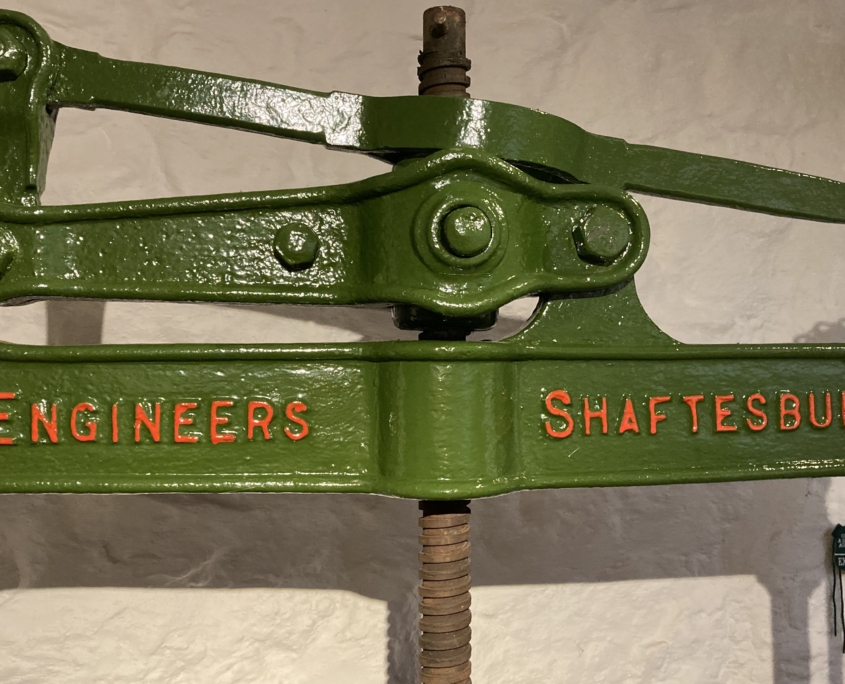Diary of Events
EVENTS 2024
A main theme of our Exhibitions (they’re all free) is Made in Shaftesbury.
A substantial piece of Shaftesbury’s industrial past was restored and generously donated in 2023 to Gold Hill Museum by a descendant of the Farris family at whose Belle Vue Iron Works it was first manufactured. John Farris & Sons were agricultural engineers renowned for their production of steam traction engines, road rollers, shepherds’ and road menders’ huts, ploughs, chaff-cutters and other agricultural machinery. Founded by John Farris (d.1914), the engineering works in its heyday was the principal local employer. Donor Dan Wood’s grandmother was the daughter of a grandson of John, Stanley Farris, who was running the firm at the time of its closure in 1975. Dan acquired the redundant cheese press, from the Taunton area, more than a decade ago after it had been neglected and left outside in the elements. It was unusual in that the Farris name and Shaftesbury were clearly visible in the casting, and (from our point of view) it was small enough to put on display in Room 2 Farming Life, after many hours of repair and restoration by Dan.
Since we couldn’t possibly accommodate a full-size steam traction engine, we have long been pleased to have on loan from the Farris family a model engine “Kitty” built over three years by the second son of John, William. Dated 1897, “Kitty” has a sovereign mounted in the smoke-box door, and is prominently displayed in Room 4 Life in the Town. Until 1975 “Kitty” was on show in the engineers’ office in Victoria Street. Dan recalls seeing the model in a glass case in Stanley’s living room.
Our Temporary Exhibition in Room 6 provides more information about the Farris Works, and in particular its shepherds’ huts. Here also is told the story of Charles Prideaux, who in partnership with brother George built up a thriving business in dairy and meat products, supplied to national outlets from the 1888 C & G Prideaux creamery in Motcombe. Like the Farris plant, virtually all trace of this has disappeared.
Southcombe Brothers began making gloves (right) in 1847. The firm catered for the UK and international market until closure in 2014. Just visible in the photograph are bricks from the Hawkers Hill Brickworks, which worked until 1939. Over a million of these bricks went into the Grosvenors’ 1895 rebuilding of Motcombe House (now Port Regis School).
Four local water mills on the River Stirchel produced stoneground flour for a prodigious number of Shaftesbury bakeries. Cann Mill still operates, under the management of the fifth generation of millers Stoate and Sons.
Childhood is the theme for displays in the Large Exhibition Room. Here there is space to do justice to the marvellous Dolls’ Houses hand-crafted by the late Tryphena Orchard. There are four miniature room settings in individual boxes, ranging from a Roman interior to a lavishly furnished Victorian drawing room occupied by authentically costumed residents. Tryphena also generously gave the Museum three much larger model buildings: two semi-detached houses in 1920’s Art Deco style with roof terraces, planters and garden furniture, and a two-storey Tudor Tea Rooms. All three buildings are connected by an imaginative backstory which enabled Tryphena to decorate and furnish the interiors in superbly convincing detail, the tiny accessories including crockery, cakes, cooking facilities, and even a pet cat.
Over the winter period Gold Hill Museum offers a series of monthly lectures for members of The Shaftesbury & District Historical Society and public.
Tisbury History Society also provides an interesting programme of lectures in the Hinton Hall, Tisbury at 7.30p.m. on the second Tuesday of the month. Gillingham Local History Society meets at 7p.m. on the third Tuesday evening of the month at Wyke Primary School Gillingham.
(Above) Detail of a Cheese Press Made in Shaftesbury at the Belle Vue Ironworks of John Farris & Sons. Very kindly repaired, restored and donated by Dan Wood. On show in Room 2 Farming Life
(Below) Gloves Made in Shaftesbury at the Wincombe Lane factory of Southcombe Brothers until closure in 2014. The driving gloves (left) were supplied to British Home Stores in the 1960s, while specialist gloves were made for police, military, and fire and rescue services
Miniature Tea Rooms and Cake Shop created by Tryphena Orchard



